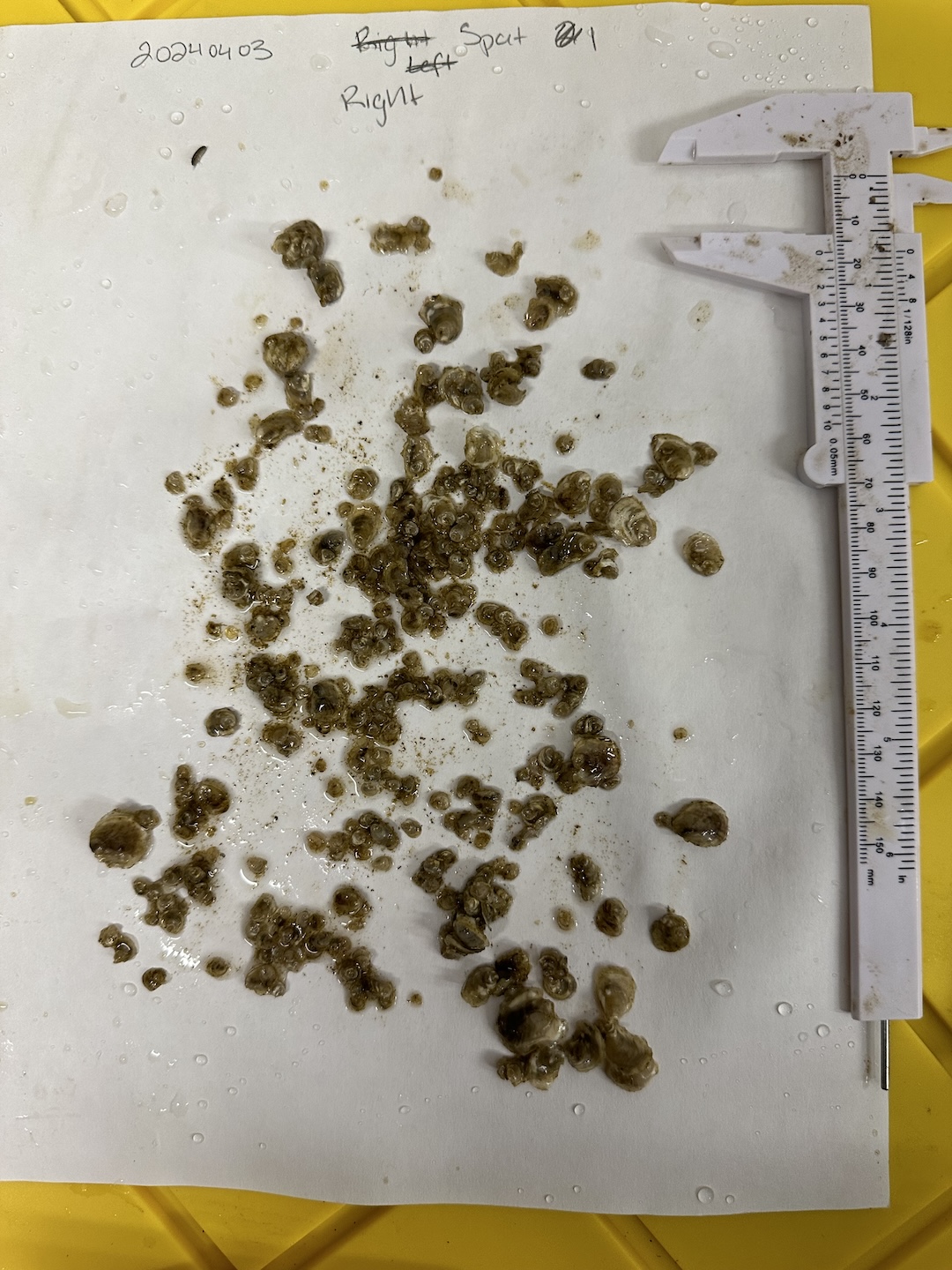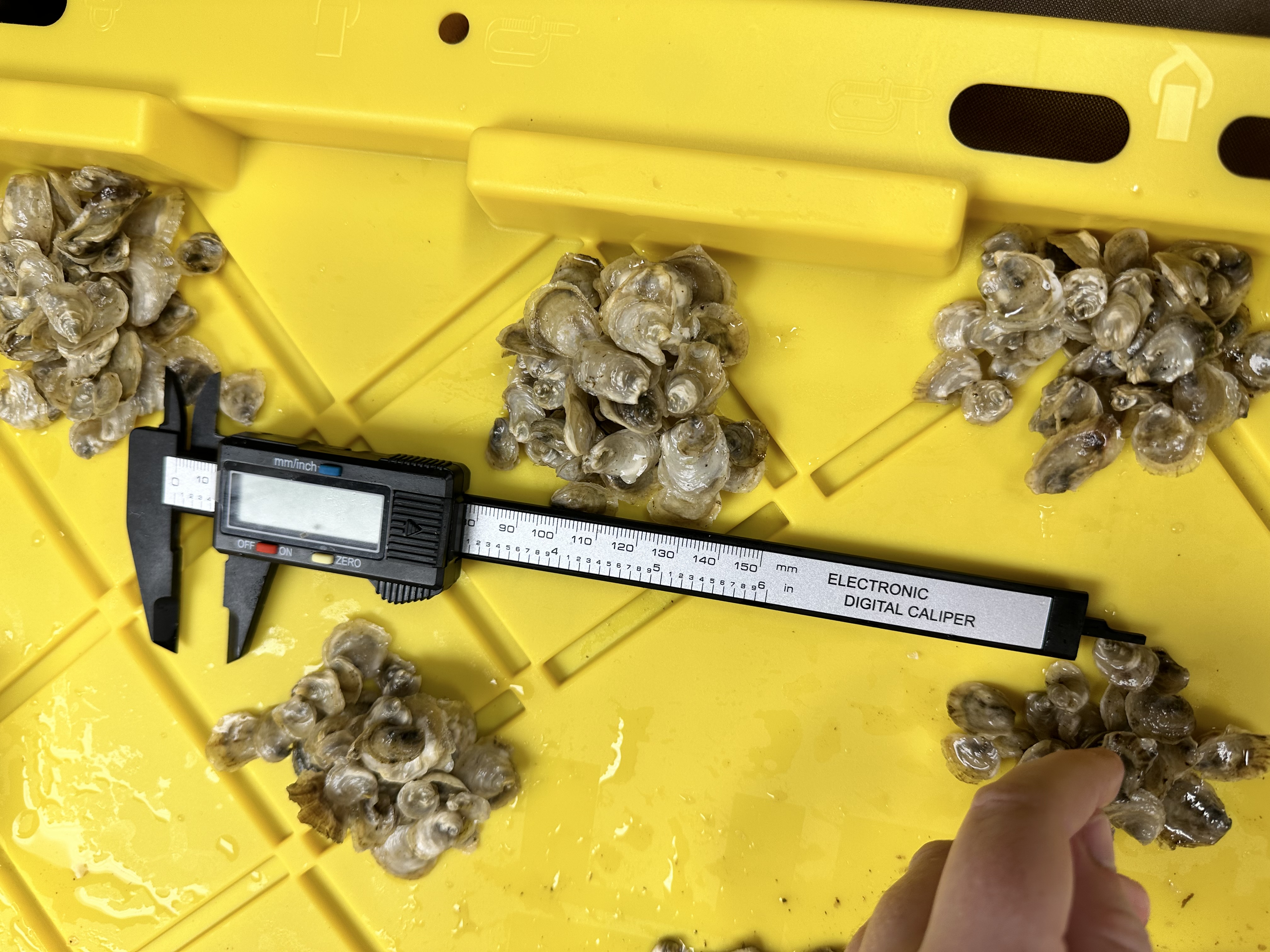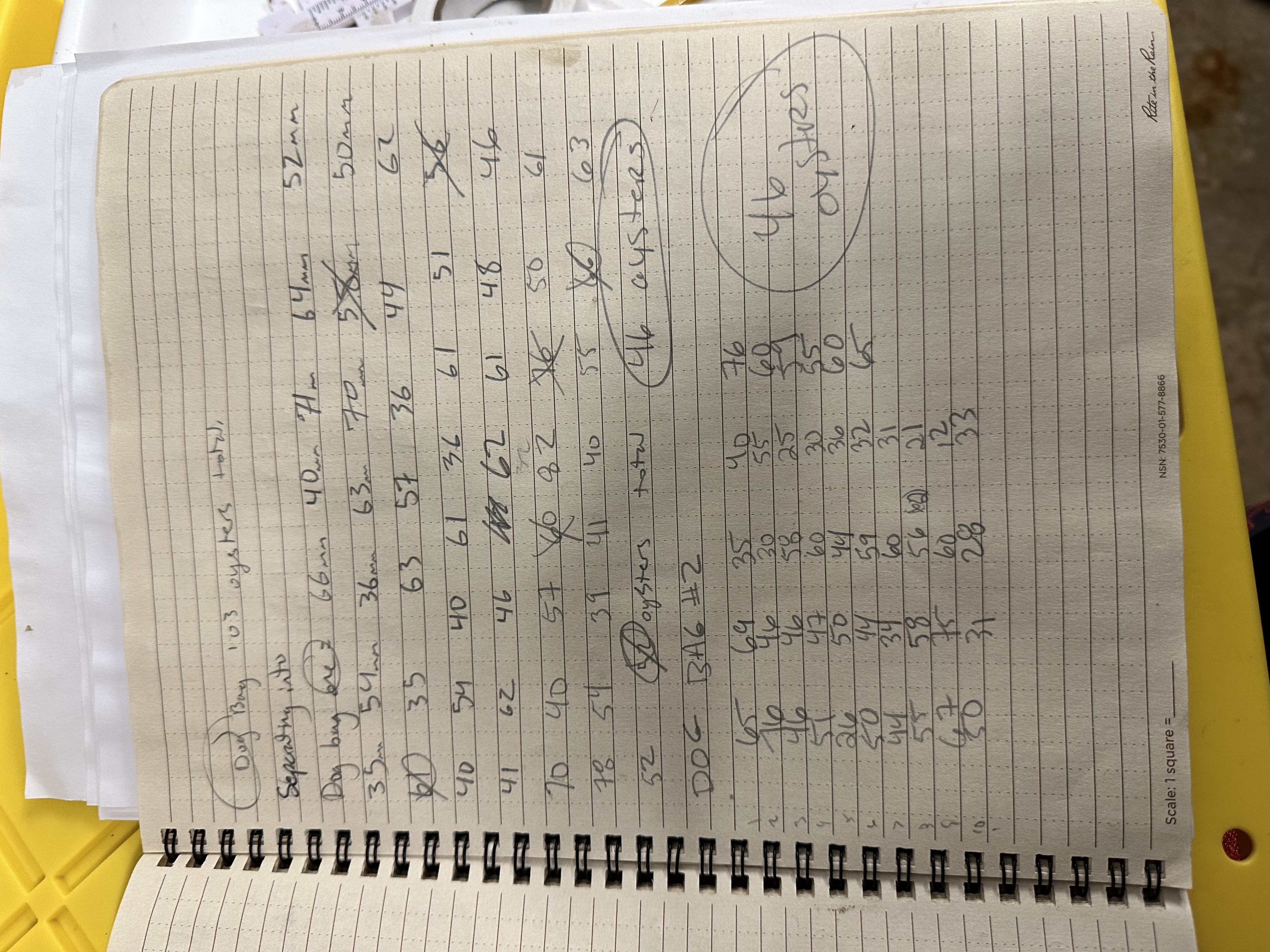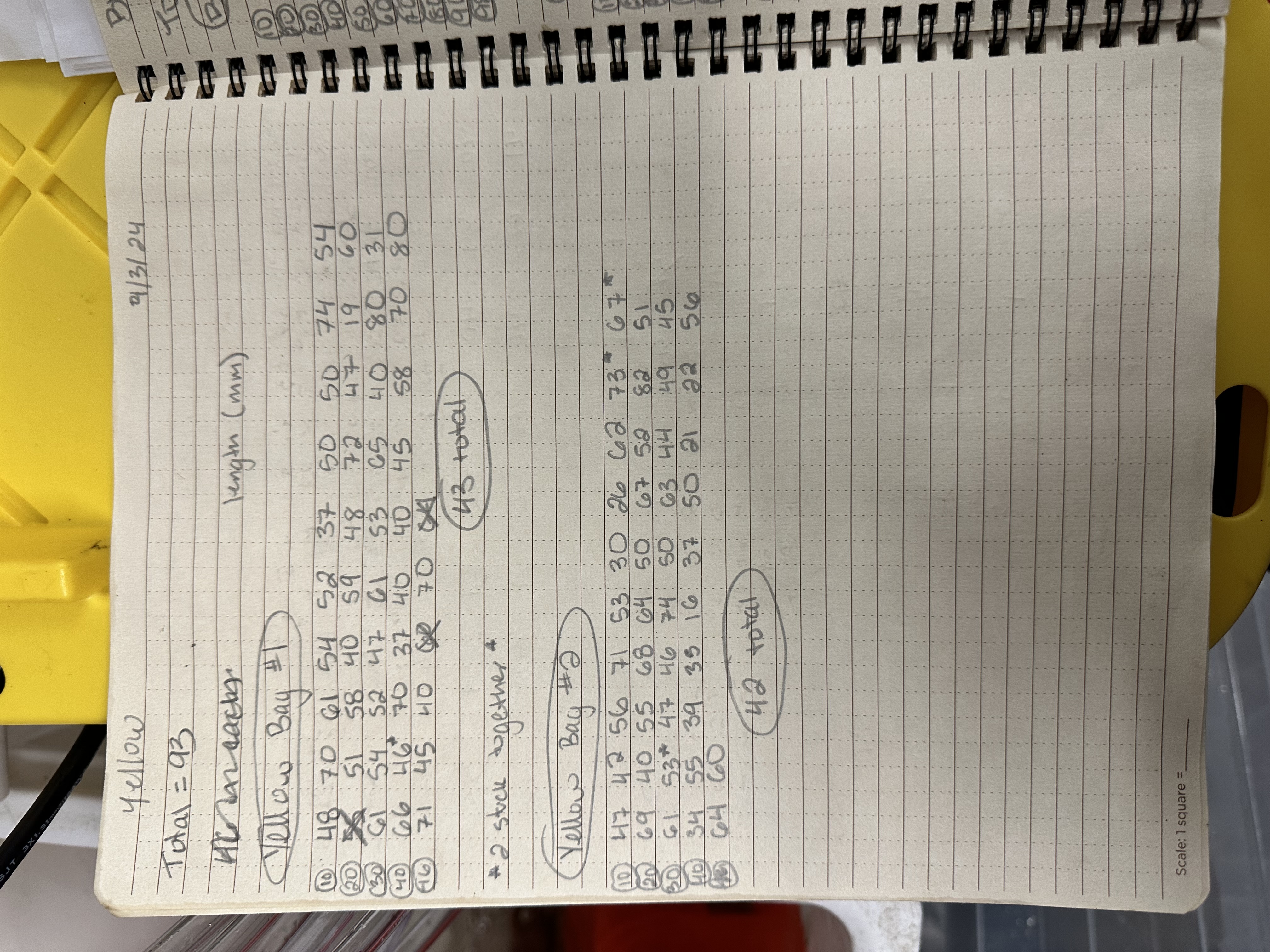Hatchery field day at Point Whitney April 3 2024
This post details activities at Point Whitney from 3 April 2024 trip.
Overview
Today we continued maintenance of the lifestage carry over project and started new conditoining exposures for spat and adults.
We have 4 projects/aims in our current work out at Point Whitney.
Project list
Lifestage carry over (LCO)
In this project, we exposed spat, seed, juveniles (all from POGS 2023 spawn at multiple size classes), and adults (Pacific Hybreed) to thermal conditioning in Oct-Nov 2023 and conducted an acute thermal stress test in Feb 2024 to investigate effects of thermal conditioning on tolerance. We are continuing to monitor growth of these groups as temperature is slowly increased to test for long term effects of conditioning on phenotypes.
The lifestage carry over GitHub repository is here.
See previous posts on this project in my notebook and Eric’s notebook.
POGS weekly seed conditioning
In this project, we are conducting weekly, short stress exposures (24°C for 30 min) on POGS 2023 seed reared in Point Whitney trays. These seed will be outplanted in May to evaluate the effect of thermal conditioning on field performance.
This project is included in the project-gigas-conditioning GitHub repository.
POGS daily seed conditioning
In this project, we are exposing seed to daily 6h exposures at 25°C. These seed are from POGS 2023 spawn that have been reared in Point Whitney trays. We will outplant seed in May to evaluate field performance.
This project is included in the project-gigas-conditioning GitHub repository.
Adult daily conditioning
In this project, we are exposing adults from 4 Pacific Hybreed families (Dog, Bird, Orange, Blue, and Yellow; same families as in lifestage carryover project) to daily 6h exposures at 25°C. We will outplant adults in May to evaluate field performance.
This project is included in the project-gigas-conditioning GitHub repository.
Project 1. Lifestage Carry Over
Today, I increased the temperature in the LCO tank by 2°C, from 16°C to 18°C. We moved all LCO animals and equipment to the far left tank to make room for new exposures. We added a recirculating pump to this tank and dosed in extra food to get the tank started.

We took growth measurements of all animals today and photos of spat for image analysis.
Here are the notebook images from today. I need to next enter this data into the datasheet.
We added new labels onto each bag because the waterproof paper was wearing off. I added labels to each bag using electrical tape and numbered them #1-#30. See notebook images below for the new labels and growth measurements.
For a subset of measurements, I took repeated size measurements to characterize measurement error. Lengths are variable based on the location of the measurements and variability in the shell shape. In general there is about 1-1.5mm error in these measurements. We took measurements with a digital caliper at 0.1mm resolution.






Here are the spat images for image analysis. Ariana will need to enter and manage this data next.




Project 2. POGS weekly seed conditioning
We continued weekly seed exposures as detailed previously here and here. Seed were exposed to 24°C for 30 minutes in a large bin of heated seawater.
Project 3. POGS daily seed conditioning
We started new seed conditioning today. We pulled new seed from 2023 POGS cohort that has been reared at ambient conditions at Point Whitney in outdoor trays.
We set up the middle white tank and the right white tank for new conditioning. The middle tank will be ambient temperature and the right tank will be our treated tank. Every day, the treated tank (right) will be heated to 24°C (from 00:00-06:00).
Before adding animals, we added bleach to the tanks and recirculated the bleach through tubes and PVC pipes to clean the system. The system was then flushed and rinsed and refilled.
We counted seed into groups of 50. We allocated these groups into 16 100um mesh bottom chambers. Eight of these chambers (#1-8) are going into an ambient tank (middle) and the other 8 (#9-16) are going into the treated tank.




We measured the size of a subset of seed (50 seed) to calculate average starting size.
We also allocated about 100 seed to each of four orange mesh bags as additional material to work with. We put two bags (#1 and #2) at ambient and two bags (#3 and #4) in the treated tank.
Here are the notebook pages from this project today.

Project 4. Adult daily conditioning
We allocated our remaining individuals of the diploid/triploid Pacific Hybreed adults from 5 families: Dog, Bird, Yellow, Orange, and Blue.
We counted all adults from each family, rinsed them, and then allocated half to an ambient tank bag (Family - Bag #1) and treated tank bag (Family - Bag #2). We measured all individuals to the nearest 1 mm before adding to bags. Bags had between 43-100 individuals per bag depending on how many were available from that family. We did not see any mortality.
Here are the notebook pages from today. These sizes will need to be entered and pushed to the GitHub repo once Ariana sets up the file structure.






Things that need to be done in upcoming visits
- Organize data, outline experimental design, and enter size data (AH)
- Analyze LCO growth data and image size analysis (AH)
- Weekly seed stress with seed from outdoor trays
- Increase temperature to 18°C in Lifestage Carry Over tank (far left tank) during the week of April 15th
- Launch temperature loggers (AH will place an order for these)
- Take weekly measurements of pH, temperature, and salinity using probes (AH will place an order for a multi probe)
- Take fluorometry measurements to characterize food delivery in large tanks
- Take May LCO growth measurements (AH)
- Outplant adults and seed in May and prepare for spawning in May
- Decide on sampling we want to do before outplanting


